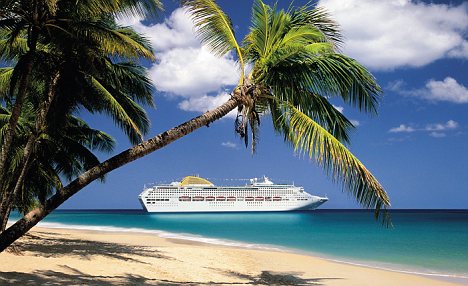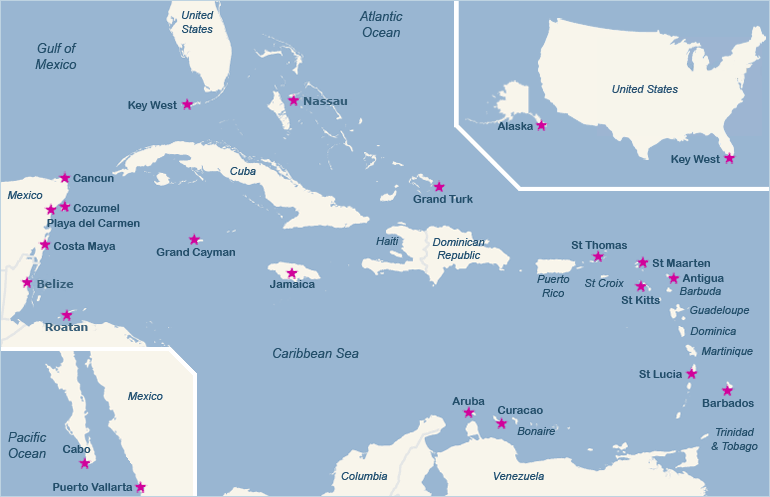Cruise Jewelry—What's the problem?
The day is beautiful, the jewelry is beautiful and, of course, the price is "discounted" – the VIP card from the ship's shopping consultant guarantees that.
So what's wrong with these purchases?
We've often warned insurers to be careful about covering jewelry bought on vacation, particularly jewelry bought on cruises. Here's some background to back up that warning.
The bigger picture
Each year an estimated 200 US cruise ships bring over 14 million tourists to island nations in the Caribbean and the Bahamas. Some of these islands are quite small, and cruise tourism is their only source of income. At each port of call, shops are the main sight and shopping often the only activity.
Jewelry is big business at these destinations. Shopping consultants on board ship stir up excitement in advance. There's likely to be a talk on some jewelry basics, such as the 4 Cs of diamonds. Shopping consultants distribute coupons from various stores for gifts like a free gemstone or free earrings.
The consultant promises to guide the passengers to the best shops. Jewelry prices can be very high, warns the consultant, but because of his connections he can bargain on the passengers' behalf. Once the travelers disembark, the expert guides them to certain shops, introduces them to this shop owner or to that special salesperson, and helps negotiate the final price for each purchase.
Passengers have the impression that the expert shopping consultants are employees of the cruise line. Actually the consultants are hired and trained by independent contractors who negotiate with shops to gain a commission on each sale they facilitate, and they pay the cruise line a percentage of their commission. The consultant's job is to help make sales happen.
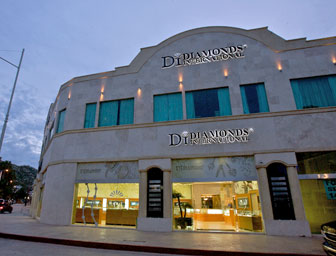
One of 125 Diamond International locations |
The shops, for their part, are up against stiff competition. High tourist seasons lasts only a few months, and in that time they must pretty much make their year's income.
They overprice jewelry because they know that cruise passengers are told to expect 70% discounts. From their profits they must pay commissions to the cruise consultants who bring customers to their shop. And they are in competition with each other, large international chains as well as mom-and-pop jewelry stores, so pressure is very high to sell sell sell.
A former shopping consultant who worked on cruise lines says that a jewelry shop along the cruise route has about 15 seconds to catch the attention of a tourist and start a dialog. The salesman's first step is to up-sell the free-gift coupon into a sale—say, by having the free gemstone put in a setting. Once that sale is closed, he'll quickly move on to more expensive pieces. He may mention to the customer that his store is approved and guaranteed by the cruise ship (which is not really the case, but the verbal assurance is part of the spiel).
Back on board, the customer is reminded to register her purchase with the ship in order to "activate the guarantee." What the registration really does is give the ship a way to keep track of expected commissions and to verify that the store is reporting all the sales.
There are also one or more jewelry stores on the ship—with overpriced jewelry. Colored gems are especially popular, and customers are often lured with free earrings or pendants. See our earlier issue on Vacation Jewelry, which highlights some of the colored gems commonly hyped on cruises and in other tourist locations.
On the way home the ship's store is likely to have a huge sale, offering passengers their end-of-vacation last chance to bring home a piece of jewelry. The special "discounted" price may prove to be what the jewelry is really worth—or it may not.
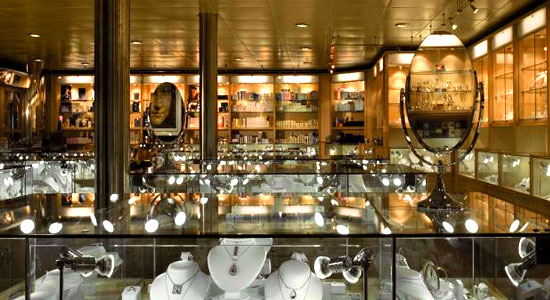
Luxury jewelry store aboard a cruise ship |
Incredible jewelry selling machine
One former shopping consultant refers to these vacation cruises as an "incredible jewelry selling machine." The system has been going on for decades, and as cruise vacationers increase in number, so do jewelry stores along the route. Diamonds International—along with its sister stores, Tanzanite International and others—has 125 stores spread almost exclusively along the cruise routes.
Not all jewelry stores in these ports artificially inflate prices and pay commissions to shopping guides, but they are all in competition for sales. What all the stores in ports and onboard the cruise lines have in common is a captive customer group, vacationers who are relaxed and open to persuasion, encouraged to pamper themselves, and primed to spend. These tourists are likely to buy on impulse, especially in the face of bogus "discounts." They usually have little or no knowledge of the product and are making purchases based the seller's and consultant's word rather than on comparison shopping.
Here are some consumer experiences . . . .
About that bargain:
We purchased a diamond that was priced at $6000+ but was happily reduced to $3000. When we took the stone to our jeweler at home to have it appraised for insurance, it was valued at $2000.
The cruise director personally was in the store and negotiated the "absolute best price" for us. When we got home and had it appraised we found out we paid $4,000 more than it is worth!
About that appraisal:
I purchased what was represented to me as a 1 carat cushion cut tanzanite with .30 carats in diamonds set in white gold. After I left the store I saw on the appraisal from the seller that the carat and gold had a line drawn through it and sterling silver had been written in.
About the fine print:
The fine print on the sales receipt disallows the return of any stone; however you can return the purchase for a store credit, provided you use the credit to make a purchase of twice the dollar amount.
Once they leave the port or the ship, these customers have little recourse.
The above remarks were selected from scores, probably hundreds, of complaints on Internet sites. We have no way of verifying these specific complaints. But knowledge of how the cruise ship selling machine operates, along with the experience of insurers who practice due diligence before insuring jewelry, leads us to advise extreme caution when insuring vacation jewelry in general, and cruise jewelry in particular.
FOR AGENTS & UNDERWRITERS
What's wrong with cruise jewelry?
- The jewelry may be of lower quality than was stated by the seller.
- An appraisal from the seller is likely to have inflated quality descriptions and valuation.
- Appraisal may not disclose color or clarity treatments, which substantially lower the value of a gem.
- The purchase price may be higher than a realistic market value.
What should the agent/underwriter do?
Ask for, and keep on file, all documents relating to the purchase. Treatments such as fracture-filling may not be disclosed on the appraisal, but they may be mentioned in boilerplate text in brochures, "certificates of authenticity," or other materials supplied by the seller. In the event of a claim, these materials may provide important information.
Ask for an appraisal written not by the seller. The best appraisals include the JISO 78/79 appraisal form, and are written by a qualified gemologist (GG, FGA+, or equivalent) who has additional insurance appraisal training. One course offering such additional training is the Certified Insurance Appraiser™ (CIA) course of the Jewelry Insurance Appraisal Institute.
Note that "Gemologist, GIA" after an appraiser's signature is not the same as GG (Graduate Gemologist). GG is a credential awarded to one who has completed a course of training that includes hands-on lab work, as well as study of gems. And the single word "gemologist" after the appraiser's name is not a credential at all, and it does not signify training or expertise.
Not all pieces bought on vacation are low-priced trinkets. They may be 6- or 7-figure items, even name brands. But they might still have inflated valuations or bogus appraisals, so don't be thrown off guard.
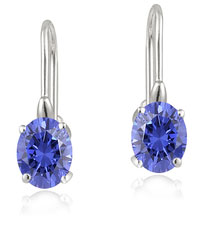
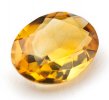
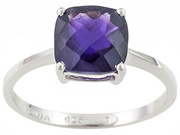
Colored stones such as amethyst, citrine and tanzanite, are big sellers on cruises. Review our earlier issue on Vacation Jewelry, which highlights colored gems popular in tourist areas.
For all jewelry of substantial value, ask for a lab report in addition to an appraisal from a Graduate Gemologist.
These are the major trustworthy labs, and you can use these links to verify gem reports you receive.
GIA
AGL
Gübelin
AGS Report Verifcation
GCAL Certificate Search
FOR ADJUSTERS
Always have a damaged stone examined in a gem lab to verify its identity and quality before settling the claim.
Carefully examine all documents on file. A treatment such as fracture-filling (or clarity enhancement), which substantially lowers the value of a gem, may not be disclosed on the appraisal, but it may be mentioned in boilerplate text in brochures, "certificates of authenticity," or other materials supplied by the seller.
Disreputable or non-existent labs can say anything on a certificate and never be called to account. Avoid basing a settlement on a report from a lab you do not know to be reliable.
These are the major trustworthy labs, and you can use these links to verify reports you receive.
GIA
AGL
Gübelin
AGS Report Verifcation
GCAL Certificate Search
©2000-2025, JCRS Inland Marine Solutions, Inc. All Rights Reserved. www.jcrs.com

